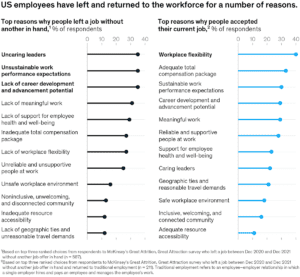No hybrid option? Then Gen Z might quit.
Published on “Mind the Gap” Newsletter from McKinsey & Company on 17th May 2022.
Much of Gen Z has never known a workplace that wasn’t flexible, and it looks like hybrid work is here to stay. It’s popular overall, but young people are especially attached: workers 18 to 34 years old are 59 percent more willing to walk than older colleagues if it’s taken away.
Once you’ve had the sweet, sweet taste of working in your jogger set from your couch, it’s hard to give it up. Plus, having no commute can mean a better work–life balance, something workers are looking (and looking elsewhere) for.
These new views on flexibility might require employers to relax where, when, and how work gets done—does it really matter if the person did their work at their desk or a coffee shop, as long as they made their EOD deadline? Four out of five hybrid or remote workers say that having control over how work is completed was a reason they took their current job.
We’re still looped in all the time: your coworkers are only an email or a virtual meeting away. Or a DM. Or a text. Or a call …
Still, it’s not all thumbs up for employers: rolling out the virtual welcome mat and helping new coworkers feel a sense of belonging can be difficult, and harmful “in group” and “out group” dynamics can crop up. Real inclusion is hard enough, and creating a better company culture without everyone in the same room is a work in progress.
Offices are evolving, looking toward the future, thinking about new—and different—talent, and just taking in Gen Z’s new vibe: we’re often less formal, look for personal investment from our bosses, and question the status quo. Having a hybrid work option goes on that list too.
In the US, workers have left jobs with uncaring bosses, unsustainable expectations, or no growth opportunities and gravitated toward those with workplace flexibility.




